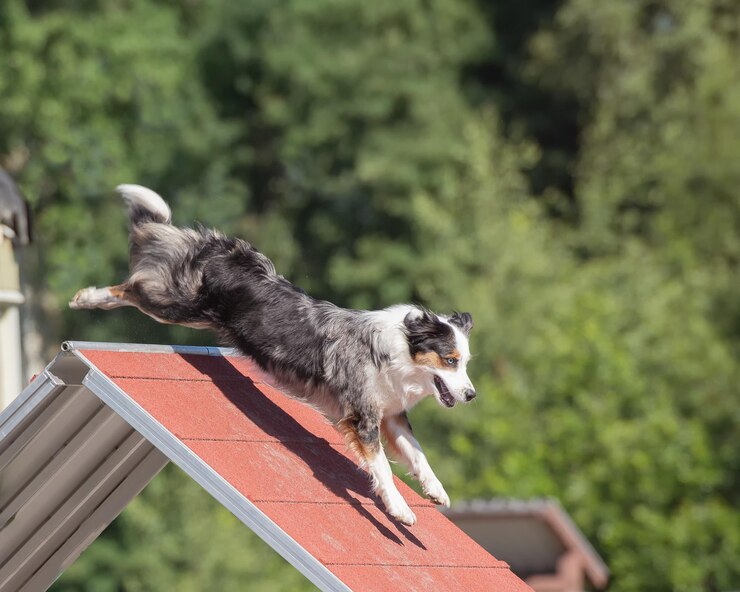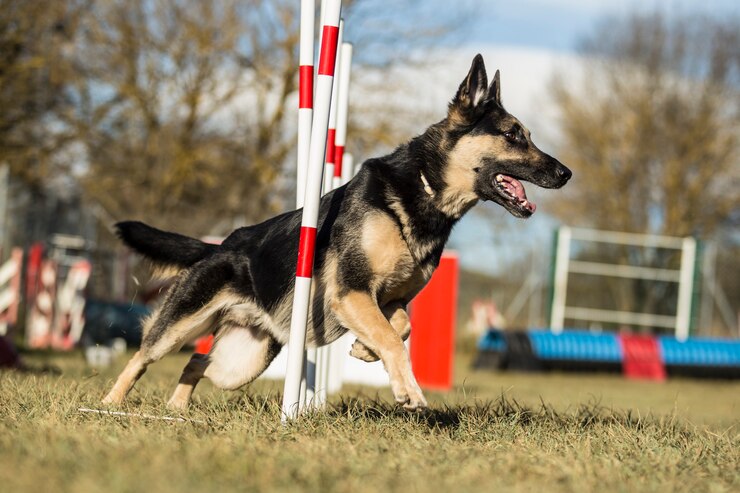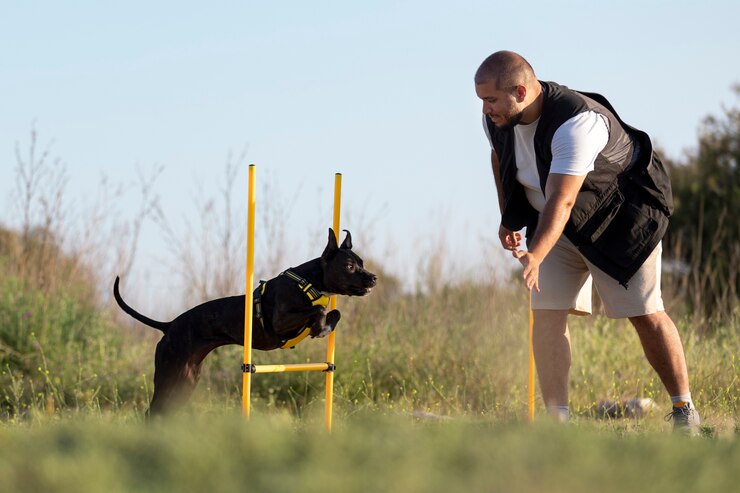If you want to improve your dog’s fitness and mental stimulation, agility training for dogs could be the answer. In agility training, you guide your dog through a timed course that includes jumps, tunnels, and weave poles. Not only is it a great physical workout, but it also provides a mental challenge that will keep your dog alert and focused.
What is agility training for dogs?
Agility training for dogs is a sport in which dogs navigate a timed obstacle course composed of jumps, tunnels, weave poles, and pathways. Agility training is an activity that benefits both dogs and their owners by keeping them in shape, healthy, and cognitively occupied.
Agility training not only provides physical exercise for the dog, but it also develops the link between the dog and its handler while improving the dog’s coordination, confidence, and problem-solving skills. It’s a fun and interactive sport for dogs of all types and sizes, as well as their owners.

Benefits of Agility Training for Dogs
Physical exercise and health benefits: Agility training provides numerous benefits to both dogs and their owners. For beginners, it’s an excellent kind of exercise that promotes your dog’s physical fitness and wellness. Regular agility training can help dogs of all ages and breeds improve their health, muscle tone, flexibility, and coordination.
Mental stimulation and cognitive benefits: Agility training for dogs is a great way to keep your dog mentally stimulated. Dogs thrive on challenges and problem-solving activities, and agility courses provide ample opportunities for them to engage both their brains and their muscles. Agility training can help reduce boredom and address behavioral concerns like excessive barking or destructive chewing.
Bonding between owner and dog: Agility training improves the link between dogs and their owners. Working as a team to overcome challenges and finish courses promotes trust, communication, and mutual respect. It’s a wonderful experience that can strengthen the bond between you and your pet.
Key Techniques in Agility Training
Agility training consists of several tactics and exercises meant to test your dog’s physical and mental capabilities. Some of the main techniques are:
Jumping exercises: Teach your dog to jump over hurdles or through hoops.
Weaving through poles: Guide your dog across a zigzag pattern of upright poles.
Tunnel training: Encourage your dog to navigate tunnels of various lengths and shapes.
A-frame and seesaw training: Introduce your dog to high obstacles like A-frames and seesaws, which demand balance and coordination.
Each of these strategies can be broken down into smaller steps to help your dog gradually learn the abilities required to complete an entire agility course.

Getting Started with Agility Training
Understanding your dog’s abilities and limitations: Before beginning agility training, it is critical to evaluate your dog’s physical condition and temperament. While most dogs may engage in agility training to some degree, you must be aware of any health issues or limitations your dog may have. Consult with your veterinarian to confirm that agility training is safe and acceptable for your pet.
Basic obedience training prerequisites: Basic obedience training is required for agility training. Before attempting agility obstacles, your dog should be familiar with instructions like “sit,” “stay,” “come,” and “heel.” These commands lay the groundwork for clear communication between you and your dog throughout agility training sessions.
Necessary equipment for agility training: Once you’ve laid the groundwork, you’ll need some basic equipment to begin agility training. Agility jumps, weave poles, tunnels, and a stable platform, such as an A-frame or seesaw, are all necessary. You can either buy these things or make your agility equipment from household goods.
Training Tips for Success
Patience, consistency, and positive reinforcement are required for successful agility training. Here are some recommendations to help you and your dog succeed:
Patience and consistency: A champion agility dog, like Rome, takes time to develop. Take your time and maintain consistency in your training efforts.
Positive reinforcement techniques: Reward your dog with treats, praise, and toys after he or she completes agility challenges. Positive reinforcement reinforces positive behavior and encourages your dog to continue trying.
Setting realistic goals: Start with simple exercises and progressively increase the complexity as your dog develops confidence and skill. Set attainable goals for each training session to keep yourself and your dog motivated.
Gradual progression in difficulty: Introduce new obstacles and difficulties gradually, allowing your dog the opportunity to acclimate and learn at their own pace. Rushing the training process can cause frustration and disappointment.

Agility Training for Different Dog Breeds
While agility training is appropriate for dogs of all sizes and shapes, some breeds may flourish at agility better than others. Border Collies, Australian Shepherds, and Belgian Malinoiss are all breeds recognized for their agility and athleticism. Dogs of any kind, even mixed breeds, can enjoy and profit from agility training if approached correctly.
It’s critical to adjust your training methods to your dog’s specific qualities and skills. For example, breeds with a strong prey drive may excel in obstacle courses that replicate pursuing and herding behaviors, whereas breeds with lower energy levels may favor slower-paced workouts that emphasize balance and coordination.
Agility Training for Puppies
Agility training may be an enjoyable and helpful sport for both puppies and mature dogs. When introducing newborn puppies to agility exercises, it is critical to proceed slowly and gently. Puppies’ developing bones and joints are prone to damage; therefore, it is critical to avoid placing too much strain on their growing bodies.
Begin with basic, low-impact exercises to help puppies develop confidence and coordination. Use plenty of goodies, praise, and playing to help your dog associate agility training with a positive experience. As your puppy grows and matures, you can gradually add more difficult obstacles and techniques.
Agility Training for Senior Dogs
Even senior dogs can benefit from agility training, with some changes to meet their evolving needs. Walking on flat ground and swimming are good low-impact workouts for aging joints. Incorporate balance and coordination exercises to help keep your dog mobile and prevent falls.
To minimize overexertion or discomfort, pay attention to your dog’s cues and alter your training as needed. Take frequent breaks throughout training sessions and pay attention to any indicators of exhaustion or soreness. With adequate care and attention, elderly dogs can continue to enjoy agility training well into their golden years.
Common Mistakes to Avoid
While agility training can be quite beneficial, it is critical to avoid several common errors that can stymie your growth. Here are some mistakes you should avoid:
Pushing too hard, too fast: Rushing through training exercises or trying complex obstacles before your dog is ready can result in frustration and fatigue.
Neglecting safety precautions: When designing agility courses, always emphasize safety first. To avoid injuries, make sure your dog’s equipment is solid and safe, and keep in mind his or her physical limitations.
Failure to adjust to the dog’s learning style: Every dog is unique, so what works for one may not work for another. Pay attentive to your dog’s indications and alter your training methods accordingly for the best results.
Finding Agility Training Classes or Clubs
If you want to advance your agility training, consider attending a local agility class or club. These organizations provide structured training programs, access to experienced instructors, and the opportunity to compete in agility trials. Training programs also offer a supportive community of other dog lovers who share your enthusiasm for agility.
To find agility training programs or groups in your region, begin by looking online or contacting other dog owners for advice. Before enrolling in a program, visit potential training facilities to witness a session and meet with the teachers. Choose a training atmosphere that is safe, helpful, and educational for both you and your dog.
Conclusion
Agility training is an excellent method to keep your dog active, mentally stimulated, and emotionally satisfied. Whether you’re looking for a fun new hobby to do with your pet or want to compete in agility trials, agility training has something for everyone. With patience, effort, and a positive attitude, you and your dog may realize your full potential and embark on an exciting agility trip together.
Now, collect your dog’s favorite treats and prepare to begin your agility training journey!
FAQs
Is agility training suitable for all dog breeds?
Yes, agility training can be tailored to dogs of different breeds and sizes. However, certain breeds may outperform others because of their natural athleticism and agility.
How often should I train my dog for agility?
The frequency of agility training sessions will depend on your dog’s age, fitness level, and specific demands. Begin with short, frequent sessions, gradually increasing the time and intensity as your dog improves.
Can older dogs participate in agility training?
Yes, agility training may be tailored to the needs of senior dogs. To protect your dog’s comfort and safety, stick to low-impact workouts and pay attention to his cues.
How can I find agility training classes or clubs in my area?
You can look up agility training facilities online or get suggestions from other dog owners. Before making a selection, consider visiting potential training venues to see a session and meet the teachers.
Do I need special equipment for agility training?
While specialized agility equipment is available, you can easily design your own agility course with ordinary objects. Begin with basic obstacles like jumps, tunnels, and weave poles, then build your course as you and your dog gain experience.

